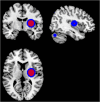Identification of texture MRI brain abnormalities on first-episode psychosis and clinical high-risk subjects using explainable artificial intelligence
- PMID: 36385133
- PMCID: PMC9668814
- DOI: 10.1038/s41398-022-02242-z
Identification of texture MRI brain abnormalities on first-episode psychosis and clinical high-risk subjects using explainable artificial intelligence
Abstract
Structural MRI studies in first-episode psychosis and the clinical high-risk state have consistently shown volumetric abnormalities. Aim of the present study was to introduce radiomics texture features in identification of psychosis. Radiomics texture features describe the interrelationship between voxel intensities across multiple spatial scales capturing the hidden information of underlying disease dynamics in addition to volumetric changes. Structural MR images were acquired from 77 first-episode psychosis (FEP) patients, 58 clinical high-risk subjects with no later transition to psychosis (CHR_NT), 15 clinical high-risk subjects with later transition (CHR_T), and 44 healthy controls (HC). Radiomics texture features were extracted from non-segmented images, and two-classification schemas were performed for the identification of FEP vs. HC and FEP vs. CHR_NT. The group of CHR_T was used as external validation in both schemas. The classification of a subject's clinical status was predicted by importing separately (a) the difference of entropy feature map and (b) the contrast feature map, resulting in classification balanced accuracy above 72% in both analyses. The proposed framework enhances the classification decision for FEP, CHR_NT, and HC subjects, verifies diagnosis-relevant features and may potentially contribute to identification of structural biomarkers for psychosis, beyond and above volumetric brain changes.
© 2022. The Author(s).
Conflict of interest statement
The authors declare no competing interests.
Figures





Similar articles
-
Brain Fractal Dimension and Machine Learning can predict first-episode psychosis and risk for transition to psychosis.Comput Biol Med. 2025 Jul;193:110333. doi: 10.1016/j.compbiomed.2025.110333. Epub 2025 May 26. Comput Biol Med. 2025. PMID: 40424766
-
Chaos analysis of the brain topology in first-episode psychosis and clinical high risk patients.Front Psychiatry. 2022 Oct 13;13:965128. doi: 10.3389/fpsyt.2022.965128. eCollection 2022. Front Psychiatry. 2022. PMID: 36311536 Free PMC article.
-
Disorganized Gyrification Network Properties During the Transition to Psychosis.JAMA Psychiatry. 2018 Jun 1;75(6):613-622. doi: 10.1001/jamapsychiatry.2018.0391. JAMA Psychiatry. 2018. PMID: 29710118 Free PMC article.
-
P300 as an index of transition to psychosis and of remission: Data from a clinical high risk for psychosis study and review of literature.Schizophr Res. 2020 Dec;226:74-83. doi: 10.1016/j.schres.2019.02.014. Epub 2019 Feb 25. Schizophr Res. 2020. PMID: 30819593 Free PMC article. Review.
-
Structural neuroimaging across early-stage psychosis: Aberrations in neurobiological trajectories and implications for the staging model.Aust N Z J Psychiatry. 2017 May;51(5):455-476. doi: 10.1177/0004867416670522. Epub 2016 Oct 12. Aust N Z J Psychiatry. 2017. PMID: 27733710 Review.
Cited by
-
Towards Personalised Mood Prediction and Explanation for Depression from Biophysical Data.Sensors (Basel). 2023 Dec 27;24(1):164. doi: 10.3390/s24010164. Sensors (Basel). 2023. PMID: 38203024 Free PMC article.
-
Magnetic resonance texture analysis reveals stagewise nonlinear alterations of the frontal gray matter in patients with early psychosis.Mol Psychiatry. 2023 Dec;28(12):5309-5318. doi: 10.1038/s41380-023-02163-3. Epub 2023 Jul 27. Mol Psychiatry. 2023. PMID: 37500824
-
Explainable AI in Diagnostic Radiology for Neurological Disorders: A Systematic Review, and What Doctors Think About It.Diagnostics (Basel). 2025 Jan 13;15(2):168. doi: 10.3390/diagnostics15020168. Diagnostics (Basel). 2025. PMID: 39857052 Free PMC article. Review.
-
Magnetic resonance imaging-based machine learning classification of schizophrenia spectrum disorders: a meta-analysis.Psychiatry Clin Neurosci. 2024 Dec;78(12):732-743. doi: 10.1111/pcn.13736. Epub 2024 Sep 18. Psychiatry Clin Neurosci. 2024. PMID: 39290174 Free PMC article.
-
Identification of texture MRI brain abnormalities on Fibromyalgia syndrome using interpretable machine learning models.Sci Rep. 2024 Oct 9;14(1):23525. doi: 10.1038/s41598-024-74418-0. Sci Rep. 2024. PMID: 39384824 Free PMC article.
References
-
- Borgwardt SJ, Riecher-Rössler A, Dazzan P, Chitnis X, Aston J, Drewe M, et al. Regional gray matter volume abnormalities in the at risk mental state. Biol Psychiatry. 2007;61:1148–56. - PubMed
-
- Chopra S, Fornito A, Francey SM, O’Donoghue B, Cropley V, Nelson B, et al. Differentiating the effect of antipsychotic medication and illness on brain volume reductions in first-episode psychosis: a Longitudinal, Randomised, Triple-blind, Placebo-controlled MRI Study. Neuropsychopharmacology. 2021;46:1494–501. - PMC - PubMed
-
- Fusar-Poli P, Deste G, Smieskova R, Barlati S, Yung AR, Howes O, et al. Cognitive functioning in prodromal psychosis: a meta-analysis. Arch Gen Psychiatry. 2012;69:562–71. - PubMed
Publication types
MeSH terms
Grants and funding
LinkOut - more resources
Full Text Sources
Medical
Research Materials

